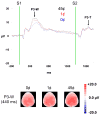The effect of graded monetary reward on cognitive event-related potentials and behavior in young healthy adults
- PMID: 16876894
- PMCID: PMC2424251
- DOI: 10.1016/j.ijpsycho.2006.05.006
The effect of graded monetary reward on cognitive event-related potentials and behavior in young healthy adults
Abstract
Temporal correlates of the brain circuit underlying reward processing in healthy adults remain unclear. The current study investigated the P3 and contingent negative variation (CNV) as putative reward-related temporal markers. The effect of sustained monetary reward on these event-related potentials and on behavior was assessed using a warned reaction-time paradigm in 16 young healthy subjects. Monetary reward (0, 1 and 45 cents) varied across blocks of trials. While the CNV was unaffected by money, P3 amplitude was significantly larger for 45 than the 1 and 0 cent conditions. This effect corresponded to the monotonically positive subjective ratings of interest and excitement on the task (45>1>0). These findings suggest a difference between the P3 and CNV; the P3 is sensitive to the sustained effect of relative reward value, while the CNV does not vary with reward magnitude.
Figures



References
-
- American Electroencephalographic Society guidelines for standard electrode position nomenclature. J Clin Neurophysiol. 1991;8(2):200–2. - PubMed
-
- Begleiter H, Porjesz B, Chou CL, Aunon JI. P3 and stimulus incentive value. Psychophysiology. 1983;20(1):95–101. - PubMed
-
- Boyd ES, Boyd EH, Brown LE. Observations on the M-wave and the CNV in the squirrel monkey. Electroencephalogr Clin Neurophysiol. 1979;46(3):320–36. - PubMed
-
- Breiter HC, Aharon I, Kahneman D, Dale A, Shizgal P. Functional imaging of neural responses to expectancy and experience of monetary gains and losses. Neuron. 2001;30(2):619–39. - PubMed
Publication types
MeSH terms
Grants and funding
LinkOut - more resources
Full Text Sources

